Roy K.K. Potential theory in applied geophysics
Подождите немного. Документ загружается.


16.9 Downward Continuation of Electromagnetic Field 559
∂E
xa
∂z
−
∂E
za
∂x
= −iωµ
0
H
y0
(in air) (16.100)
∂E
xe
∂z
−
∂E
ze
∂x
= −iωµ
0
H
ye
(in earth) (16.101)
and H
ye
=H
ya
at z = 0. We get
∂E
xe
∂z
−
∂E
xa
∂z
= −
1 −
γ
2
a
γ
2
e
∂E
za
∂x
at z = 0 (16.102)
∂E
ye
∂z
=
∂E
ya
∂z
= −
1 −
γ
2
a
γ
2
e
∂E
za
∂y
at z = 0 (16.103)
The higher derivatives are
∂
2
E
ze
∂z
2
=
γ
2
a
γ
2
e
γ
2
a
− γ
2
e
E
za
+
∂
2
E
za
∂z
2
at z = 0 (16.104)
∂
3
E
ze
∂z
3
=
γ
2
e
− γ
2
a
∂E
za
∂z
3
+
∂
3
E
za
∂z
3
at z = 0 (16.105)
∂
4
E
ze
∂z
4
=
γ
2
a
γ
2
e
γ
2
e
− γ
2
a
+
∂
2
∂z
2
2
E
za
at z = 0 (16.106)
∂
2n
E
ze
∂z
2n
=
γ
2
a
γ
2
e
γ
2
e
− γ
2
a
+
∂
2
∂z
2
2
E
za
at z = 0 (16.107)
∂
2n+1
E
ze
∂z
2n+1
=
γ
2
e
− γ
2
a
+
∂
2
∂z
2
2
∂E
za
∂z
at z = 0 (16.108)
∂
2
E
xe
∂z
2
=
γ
2
e
− γ
2
a
E
xa
+
∂
2
E
xa
∂z
2
at z = 0 (16.109)
∂
3
E
xe
∂z
3
=
γ
2
e
− γ
2
a
∂
2
∂z
2
∂E
xa
∂z
−
1 −
γ
2
a
γ
2
e
∂E
xa
∂x
at z = 0 (16.110)
∂
2n
E
xe
∂z
2n
=
γ
2
e
− γ
2
a
+
∂
2
∂z
2
n
E
xa
at z = 0 (16.111)
∂
2n+1
E
xe
∂z
2n
=
γ
2
e
− γ
2
a
+
∂
2
∂z
2
n
E
xa
at z = 0. (16.112)
Equation (16.110) and (16.111) give the necessary guide lines to find out the
higher vertical derivatives for E
ye
16.9.1 Downward Continuation of H
z
The downward continued values of H
ze
(h) can be written in ter ms of values
on the z = 0 boundary in the form of Taylor expansion as follows
H
ze
(h) = H
ze
(0) + h
∂H
ze
∂z
z=0
+
h
2
2!
∂
2
H
ze
∂z
2
z=0
+
h
3
3!
∂
3
H
ze
∂z
3
z=0
+
h
4
4!
∂
4
H
ze
∂z
4
z=0
+----------. (16.113)

560 16 Analytical Continuation of Potential Field
Substituting (16.111) and (16.112) upto the fourth order of vertical deriva-
tives, one can write
H
ze
(h) = [H] .
Substituting (16.111) (16.112) (16.113) upto the fourth order of vertical
derivatives, one can write
H
ze
(h) =
H
za
(0)) + h
∂H
xa
(0)
∂z
+
h
2
2!
∂
2
H
za
(0)
∂z
2
+
h
3
3!
∂
3
H
za
(0)
∂z
3
+ ···
+
h
4
4!
∂
4
H
za
(0)
∂z
4
+
h
2
2!
γ
2
e
− γ
2
a
H
za
(0) +
h
4
4!
γ
2
e
− γ
2
a
2
H
za
(0)
+
h
3
3!
γ
2
e
− γ
2
a
∂H
za
(0)
∂z
2
. (16.114)
If H
xa
and H
ya
are also observed, one can use a finite difference approximation
of (16.112) and (16.113) to H
za
(0)/dz. Thus it is possible to determine H
ze
(h).
Alternately one can use Peter’s (1949) static field approximation by using
the average values of H
za
(0) on circles around the point of continuation using
suitable coefficients discussed in Sect. (16.5). That involves the development of
a numerical scheme for evaluation of the electromagnetic upward continuation
integrals (16.80).
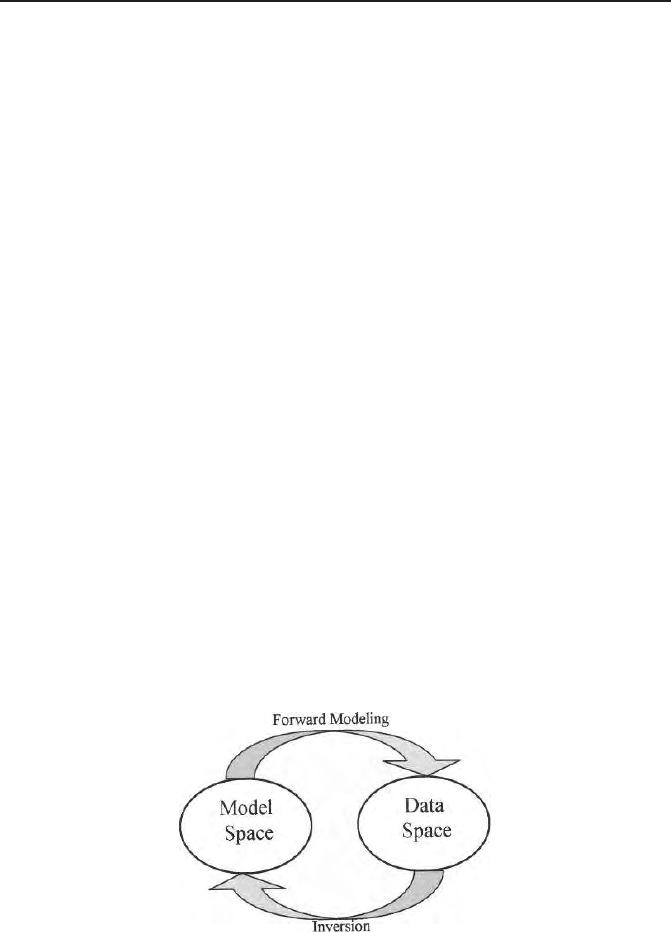
17
Inv e rsion of Poten tial Field Data
In this chapter a few basic p oints about inversion of geophysical data are given.
Structures of different approaches for inversion, viz, Singul ar Value Decompo-
sition, Lea st Squares including Ridge Regression, and Weighted Ridge Regre s-
sion, Minimum Norm Algorithm, Bachus Gilbert Inversion, Stochastic Inver-
sion, Occam’s Inversion Global Optimization Techniques including Monte
Carlo Inversion, Simulated Annealing and Genetic Algorithm, Artificial Neu-
ral Network and Joint inversion are discussed.
17.1 Introducti on
The task of retrieving complete information ab out model parameters from a
complete and precise set of data is inversion. In geophysics, these mo dels are
earth models and the task is to establish a link between a data space and
model space (Fig. 17.1).
If we have a set of data collected from the field, we try to say about the
earth model with those finite data set. How many different ways can one try
Fig. 17.1. Connecting link between a data and the corresponding model space in
a forward and an inverse problem
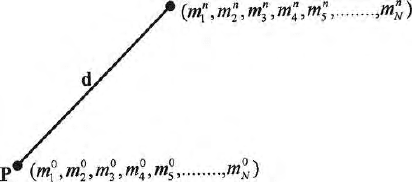
562 17 Inversion of Potential Field Data
to travel within a Data space (or domain) and a mo del space (or domain),
how good the flow of information is from a data space to a model space, what
are the difficulties can one encounter, how many different ways can one try
to overcome those difficulties, how much information can one really gather
and what are their limitations, what are the precautions can one take on
the way as one moves through the multidimensional hyperspace (Figs. 17.2
and 17.3) are some of the questions to be addressed briefly. Inverse theory
is applicable to all the branches of science and engineering. Inverse problems
are also termed as identification problems or optimization problems. It is
a part of information theory and communication theory. Inverse Theory is
the most scientific and accurate mathematical tool to be used judiciously for
interpretation of geophysical or other scientific data.
Some sense of movement, distance and projection of a structure from dif-
ferent angles are involved in an inverse problem. Data and model spaces are
assumed to be n and m-dimensional abstract spaces (Figs. 17.2 and 17.3)
where information from the data space are transmitted to the model space
and vice versa through some connecting links. We shall discuss on these links
in the text. Figure 17.2 show the distance between the starting and the end
point in an m dimensional hyperspace. This sense of distance and movement
are present both in the data and model space. These distances are d
obs
–
d
predicted
in the data space and m
true
–m
prior
in the model space. We try
to minimize these distances in both the spaces. It means that the model
with which we started our experiment has certain co-ordinates in the abstract
space. That m-dimensional co-ordinate point moves towards the actual answer
as the inverse process progresses. This is the sense of movement in an inverse
problem. These movements can b e continuous in small discrete steps or it
can b e by random jumps in the entire parameter space. What is really meant
by this movement? Here comes the concept of forward modeling. Figure 17.3
shows the different initial choices of the model parameters at differe nt places
in the m-domain but all the movement from the starting points are towards
the actual answer. An initial and judicious choice of a model is the starting
point of an inverse problem. For existence of an inverse problem, the forward
problem must exist. Therefore, solution of a forward problem is the starting
Fig. 17.2. Movement of an assumed model and the sense of distance in an N
dimensional mo del space
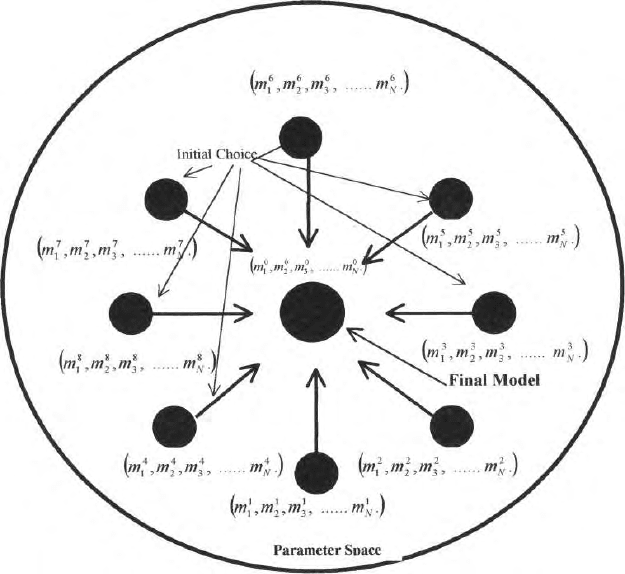
17.1 Introduction 563
Fig. 17.3. Different initial choices and in M dimensional parameter space and their
movements towards the actual answer
point of an inverse problem. Geophysicists collect a set of data on the surface
of the earth or in the air or inside a bore hole or at the ocean b ottom.What
can we say about the earth with these limited noisy data? That’s how, ‘norm’,
conver gence, metric space, inner product space, Hilbert space n-dimensional
vector space entered in an inverse problem. Figure 17.2 shows the distance
between the actual answer and the starting point.
Generally gravity / magnetic / D.C. resistively / electromagnetic / S.P. /
I.P / Seismic reflection a nd refraction / earthquake Seismology / heat flow
data are collected. Interpreters of data have to guess judiciously at this stage
on what kind of subsurface structure can generate this kind of data distribu-
tion. Interpreters must have some insight about the nature of distributio n of
data for different type of subsurface structures as well as for different types of
potential and non potential fields. Judicious choice of an initial model reduces
the distance between m
prior
and m
true
where these points are locations of
a priori or initial choice of the model parameters in an abstract space. To
achieve this insight one has to solve mathematical boundary value problems
for different types of naturally occurring or artificial man made field s and
564 17 Inversion of Potential Field Data
examine the nature of responses responsible for different types of sub surface
structures. These boundary value problems are forward problems and can be
one / two / or three-dimensional problems. With increase in complexity in
an assumed earth model, the mathematical complications in the solution of
a forward problem incre ases. Advent of numerical methods, viz., fi n i te dif-
ference, finite element, integral equation, volume integral, transmission line,
hybrids, increased the horizon of solvability of the problems of complex sub-
surface g eometry and that incr eased the horizon of applicability of inverse
problems. For the last seven decades, geophysicists solved numerous forward
boundary value problems needed for interpretation of geophysical data. Hence
inversion of geophysical data grew as a subject at a faster pace. The data we
generate by solution o f boundary value problem are noise free synthetic data
obtained from a synthetic model. These synthetic data are called d
Predicted
or d
Pre
and a synthetic model is m
Prior
.Ingeophysicsd
Observed
or d
Obvs
are
generally the field data collected on the surface of the earth or in the air or in
o cean surface or in a borehole. These are experimental data in other branch
of science and engineering and are contaminated with noise. (d
Obs
–d
Pre
)
and (m
true
–m
Prior
) are the two distances or norms we were talking about
and we try to minimize these distances in the data s pace and model space
by dual minimization simultaneously. Inverse theory is based o n a few basic
concepts(Parker 1977) viz., (i) existence (ii) construction (iii) approximations
(iv) stability and (v) nonuniqueness.
Existence : For existence of an inverse problem, forward problem must
exist The solution of a boundary value problem is either available or it is to be
solved. Solutions of forward models in analytical form are available (already
solved) for simpler sub surface geometries. With the introduction of realistic
touches in earth models, a boundary value pro blem becomes mathematically
unmanageable and one has to solve the problems numerically.
So the forward problem must be solved or at least must be available before
construction of an inverse problem. Since the model space and data space a re
respectively the Hilbert space and Euclidean space, the concept of projection
of models from different angles appear. With limited data and with limited
resolving p ower of many of the potential p roblems we can only see a projection
of the model from a particular angle. That invites a serious problem of non
uniqueness to be taken up.
Construction : Construction of a n inverse problem can be done in many
ways. It is centered around (i) examination of data and to take decision on
application of regularization (ii) judicious assumption of an initial model based
on the nature of the data (iii) solution of the forward problem (iv) comparison
of field data with the synthetic model data or predicted data (v) estimation of
the discrepancies (d
obs
–d
pre
) in data space and (m
est
–m
prior
) in the model
space quantitatively in the form of squared residuals or chi square errors or
residual variance or energy function or cost function or error function etc.
(vi) choose a particular type of inversion approach based either on linearised
inversion approach or random walk technique for global optimization approach
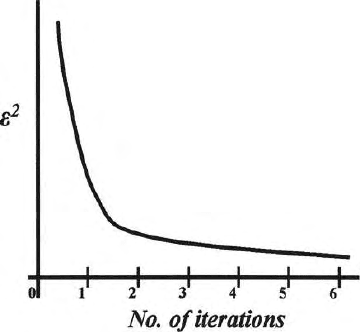
17.1 Introduction 565
Fig. 17.4. Convergence of an inverse problem in successive iterations
(vi) obtain the convergence of an iterative solutions (Fig. 17.4). (vii) find
out the uncertainly l evel in parameter estimation (ix) study the level of non
uniqueness and find out the way to overcome it if possible (x) mix some
additional information from different branches of geophysics if available and
trytogoforjointinversion.
Multi domain geophysical data based on different physical properties can be
used either for joint inversion or these additional information can be used to
constrain the model to be estimated. Some of the very well known approaches
for construction of an inverse problems are (i) Singular value decomposition
(ii) Least squares estimator (iii) Ridge regression and weighted ridge regression
estimators (iv) Min imum norm estimator for an underdetermined problem
(v) Method of steepest descent (vi) Conjugate gradient minimization (vii)
Bachus Gilbert inversion (viii) Stochastic inversion. (ix) Occa m’s inversion.
(x) Monte Carlo inversion (xi) Simulated Annealing (xii) Genetic Algorithm
(xiii) Neural network etc. This is a broad outline about the construction of
an inverse problem. There are many other approaches not listed here.
Figure 17.5 shows a schematic diagram regarding construction of some of
the inversion procedures. Procedural details are different for different inversion
approaches. Figure 17.6 shows the paths for convergence and divergence in the
parameter space starting from the initial choice.
Approximation is a major component in framing an inverse problem.
Approximation enters into the system throug h many channels. As for exam-
ples most of the geophysical problems are non-linear problems. We linearise
the non-l in ear problems by trun cating higher order terms of the Taylor’s series
expansion and introduce approximation to enter into the domain of general-
ized linear inverse problems. The effect of this truncation of higher order
terms may be less for certain problems. They are called weakly non-linear or
linearisable problems. Fo r certain other cases the effect of linearization may
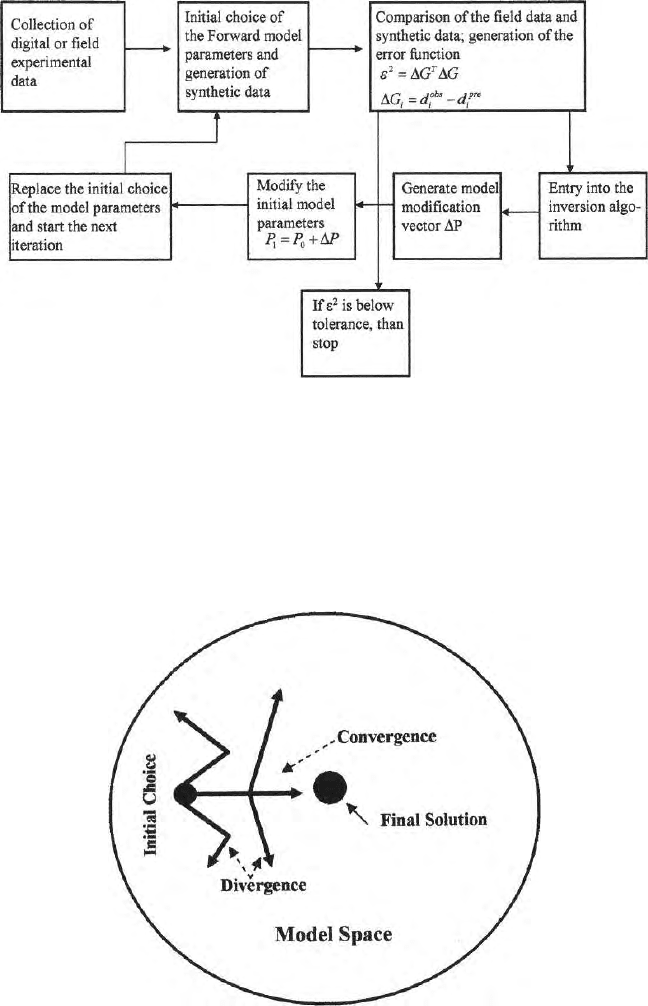
566 17 Inversion of Potential Field Data
Fig. 17.5. A cartoon of a flow chart for an inverse problem
be severe. They are called strongly non-linear problems. Some of these non-
linear prob lems can be linearised at the maximum likelihood point (discussed
later) whereas some other problems cannot be linearised at all. Therefore,
for strongly nonlinear problems one should use one of the global optimiza-
tion approaches. The next major approximation enters through the choice of
Fig. 17.6. Convergence and divergence of an inverse problem as the initial model
starts moving towards the actual answer
17.1 Introduction 567
forwar d problems. E arth structure is much more complicated than whatever
forward model we choose to initiate an inverse process. The approximation
in very severe for one dimensional modeling and inversion. Only for a few
cases we g et perfect horizontal layers inside the earth. Although numerical
approaches for forward modeling viz. finite element and finite difference can
take care of a part of the degree of complications inside the earth in 2-D/3-
D forward problems, it cannot be a complete substitute for an earth model.
The interpreter must have a reasonable knowledge about the geology of the
area for proper selection of an earth model. A model widely off from the
actual earth’s subsurface will generate wrong answer even if one gets rea-
sonably good convergence of an inverse pr oblem. Approximations also enter
through data inadequacy, data smoothing and applications of several con-
straints. Some kinds of regularization, viz, Tikhnov’s regularization (Tikhnov
and Arsenin 1977), Occam’s rajor (Constable et al 1987), minimum structure
algorithm (Smith and Booker, 1991) are necessary. Data smoothing is very
common before inversion unless the data are of very high quality.
Stability of an inverse problem means smooth and trouble free move-
ment of all the parameters of a particular model towards the actual answer
and should reach nearer to the destination (Fig. 17.6). For movement from
the initial choice point in the Hilbert space, the inverse problem may start
diverging out. It means the discrepancy between the field and predicted data
and the distance b etween model values and the actual answer will also start
increasing, i.e., sum of the squared residual will start increasing instead of
decreasing. Larger the number of parameters in a model space greater will
be the probability for divergence. In the parameter space all the parameters
must move towards the actual answer. In that case the inverse problem is
stable. There are a few reasons f or an inverse problem to be unstable. These
are (i) data inadequacy (ii) data inaccuracy (iii) poor initial choice of the
model parameters (iv) generation of ill conditioned matrix with several zeros
or very small eigen values for the problems dealing with generalized inverse (v)
unconstrained optimization. Presence of several loca l minimum pockets will
not allow the system to converge. The data space and model space are con-
nected by a linear or a linear differenti al operator. Since most of the geophysi-
cal problems are nonlinear, linear differential op erators are generally used and
they construct the sensitivity matrix. If the matrix thus generated is an well
conditioned matrix, then with adequate good quality data one can generate
a well posed problem.
In an well posed problem if one gives a small perturbation in the model
parameters, small perturbation in the data space will result and vice versa.
On the other hand if a small perturbation in the data space causes large
perturbation in the model space, then the problem is an ill posed problem.
Most of the geophysical problems are ill posed problems. Zero and small eigen
values of the sensitivity matrix bring this instability. To improve stability of an
inverse problem quite a few steps are taken viz. (i) an attempt is being made
to make the problem overdetermined. An over determined problems are those
568 17 Inversion of Potential Field Data
where the number of data points (n) are more than the number of unknown
parameters (m). n greater than m does not guarantee that the problem will be
an overdetermined problems. Data must b e capable of seeing the entire earth
model within its power of detectibility. For most of the geophysical problems
it becomes possible to collect more data than the number of parameters to be
resolved from the model.
For certain geophysical problems, it may not b e possible to collect as many
data as practicable and the problem becomes underdetermined problem i.e.,
the number of data points is less than the number of unknowns parameters
(n < m). Theoretically or mathematically when n = m, we have an even
determined problem and one should be able to determine m completely. But
presence of noise in field data makes the system unstable and the problem
diverges. (ii) detailed eigen value analysis is done to study the rank deficiency
of the sensitivity matrix and to weed out the zero and small eigen values (iii)
Marquardt Levenberg co efficients or parameter variance covariance values are
added to the diagonal elements of the sensitivity matrix to ensure stability
(iv) Positivity or non negativity constraints are imp osed for not allowing any
of the parameter to be negative when it is known that the parameters to
be determined are definitely positive quantities. Constraints on upper and
lower bounds of a particular parameter can also be introduced. Constraints
on movement in the parameter space is also introduced to ensure b etter sta-
bility (v) introduction of a prior assumption from reliable other geophysical or
geological data may reduce the number of unknown parameters to be deter-
mined and thereby improve the stability condition and quality of inversion to
a certain extent.
Nonuniquenesses are very imp o rtant aspects of an inverse problem to be
taken care of. If we have or assume a model we can generate a unique respo n se
for a particular type of field. But the reverse is not true, i.e., if we have a s et
of data, infinitely many models may satisfy this set of data It is possible to
overcome this hopeless situation to a great extent and that is why the inverse
theory survived the test of time. The causes for the non uniqueness in an
inverse problem are as follows:
Nonuniqueness is due to (i) principle of ambiguity present in the potential
theory (ii) data inadequacy (iii) data inaccuracy, (iv) different form of error
present in the data (v) noise (vi) bad initial choice of the model parameters,
(vii) different types of constraints imposed, (viii) presence of several local
minima pockets in the parameter space (Figs. 17.7 a, b) (ix) simplification of
the forward model, (x) linearization of the nonlinear problem, (xi) different
approaches are adapted for solution of inverse problems, (xii) different types
of corrections applied to the data, (xiii) various types of smoothing applied
to the data. (xiv) different forward problem soft wares used to interpret same
data.
Green’s theorem of equivalent layer s in potential theory discussed in
Chap. 10 is an example of n on uniqueness present in theory. This theorem
shows that one can get same gravitational field for different type of mass
